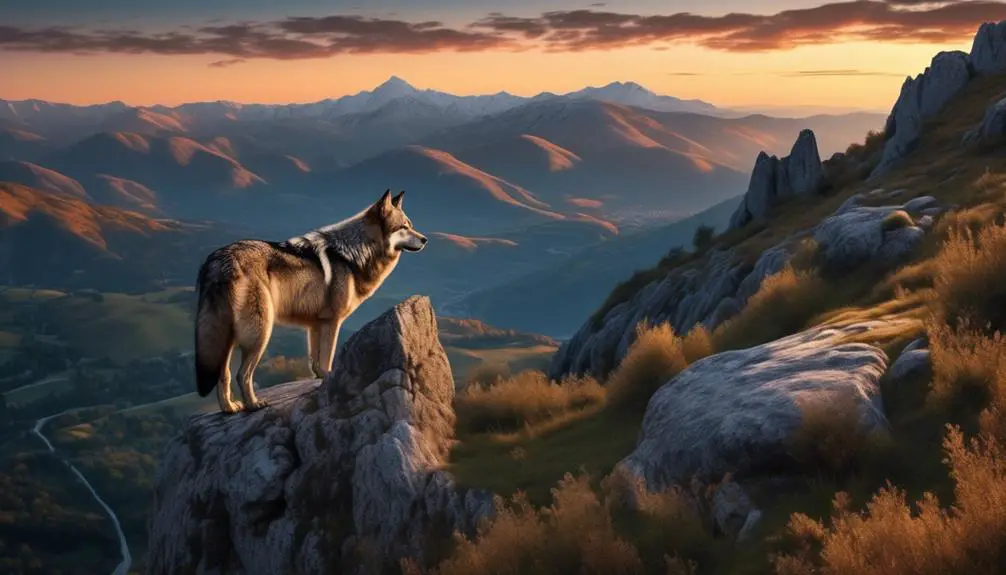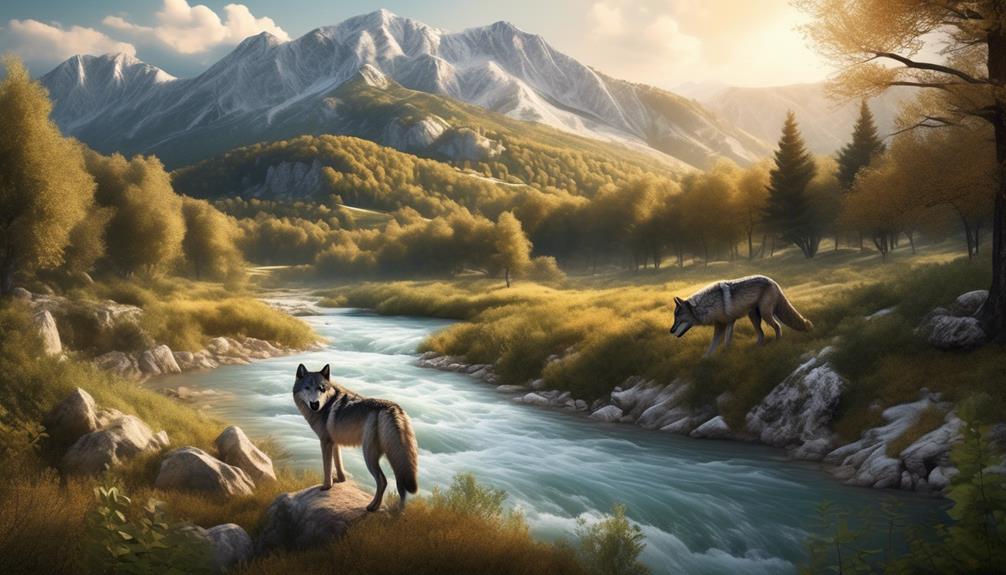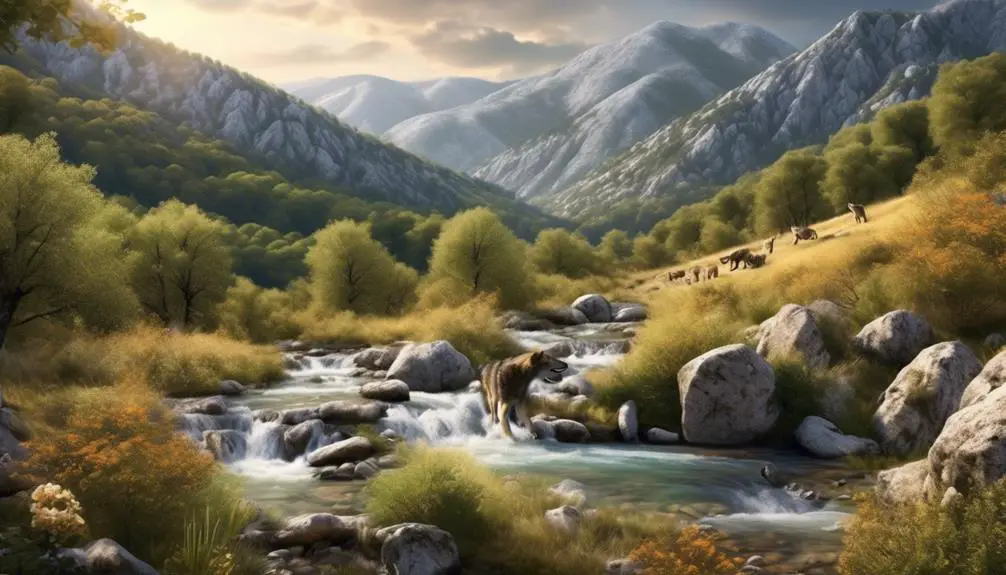This blog contains affiliate links. As part of afiiliate networks and as an Amazon Associate, I earn from qualifying purchases. If you make a purchase through these links, I may earn a small commission at no additional cost to you. I only recommend products and services that I believe in and have personally used or researched. Your support helps me continue to provide quality content—thank you!
Ready to embark on an extraordinary exploration of Italy’s wild side? Get ready to witness the wonder of wolves in their natural habitat.
In this comprehensive guide, we will unveil the top destinations in Italy where you can catch a glimpse of these elusive creatures. From the majestic Apennine Mountains to the breathtaking Dolomites, we will lead you to the very heart of wolf territory.
But that’s not all – we’ll also reveal the fascinating conservation efforts and research centers dedicated to preserving these iconic predators.
So, pack your curiosity and prepare to uncover the secrets of where to see wolves in Italy.
Wolves in Italy: An Overview

Wolves in Italy have made a remarkable comeback over the last decade, with conservation efforts contributing to the recovery of their populations in various regions of the country. The Italian wolf, a subspecies of grey wolf, is native to Italy and can be found in the Apennine Mountains, Western Alps, and Apuan Alps. These medium-sized wolves have a blended grey or brown coat and prefer isolated areas away from human settlements. However, they’re adaptable and can thrive in various climates and habitats.
Wolves in Italy are most active during late January and February, especially during the breeding season. Currently, there are more than 3,000 wolves in the wild in Italy, with populations in the Western Alps, the Dolomites, the Apennines, and the Apuan Alps. Conservation efforts have been successful in increasing wolf populations, and they can even be found on the outskirts of Rome.
Despite their reputation, wolves pose little threat to humans and are generally afraid of people. Wolf attacks on humans are rare, and no wolf attack has been recorded in Italy. They’ll avoid human settlements if possible, and they’re less aggressive compared to other large animals like bears, moose, boars, and cattle.
The Apennine Mountains

The Apennine Mountains, home to a diverse range of wildlife including the Italian wolf, offer a captivating landscape for observing and studying these remarkable creatures. With its rugged terrain, dense forests, and abundant prey, the Apennine Mountains provide an ideal habitat for wolves to thrive. Here, you have the opportunity to witness the beauty and majesty of these apex predators in their natural environment.
To help you plan your visit, here is a table showcasing some key information about the Apennine Mountains and their wolf population:
| Location | Features | Wolf Population |
|---|---|---|
| Abruzzo National Park | Oldest park in the Apennine Mountains, karst landscape, mountains, rivers | Approximately 2,000 wolves in 7-8 packs |
| Majella National Park | High Apennine mountains, rich flora and fauna | Approximately 100 wolves in 11 packs |
| The Apuan Alps | Northwest Tuscany, marble quarries, medieval villages | Recovering wolf population |
| The Western Alps | Part of the Alpine mountain range, diverse landscapes | Significant wolf population contributing to the ecological balance |
These locations offer unique opportunities to observe wolves in their natural habitat, while also allowing for the exploration of stunning landscapes and diverse ecosystems. Conservation efforts have played a vital role in the recovery and preservation of the wolf population in these areas. Visitors can participate in guided tours and wildlife experiences that focus on observing and learning about these magnificent creatures without disturbing their habitats.
Western Alps
The Western Alps are home to a significant wolf population in Italy. These wolves play a crucial role in maintaining the ecological balance of the region.
As the wolf population continues to expand towards the north and east, visitors have the opportunity to encounter these magnificent creatures while enjoying the diverse landscapes of mountains, valleys, and forests in the Western Alps.
Wolf Population in Western Alps
With a significant wolf population and diverse landscapes, the Western Alps provide an ideal habitat for these majestic creatures. Wolves in the Western Alps have been expanding towards the north and east since their return in 2014. This expansion is a positive sign of their thriving population and successful conservation efforts.
The wolf population in the Western Alps plays a crucial role in maintaining the ecological balance of the region. Their presence helps control herbivore populations and promotes a healthy ecosystem.
Visitors to the Western Alps have the unique opportunity to observe these fascinating animals in their natural habitat while enjoying the breathtaking scenery of mountains, valleys, and forests. Hiking and exploring the natural beauty of the Western Alps can lead to unforgettable encounters with these iconic predators.
Ecological Balance and Wolves
Expanding their territory in the Western Alps since 2014, wolves contribute to the ecological balance of the region by controlling herbivore populations and promoting a healthy ecosystem.
As apex predators, wolves play a crucial role in regulating the populations of herbivores such as deer and ibex. By preying on these herbivores, wolves help prevent overgrazing, which can lead to habitat degradation and loss of biodiversity.
Additionally, wolves target weaker and sick individuals, keeping the population strong and genetically diverse. Their presence also influences the behavior of herbivores, causing them to avoid certain areas and adopt more cautious behavior. This, in turn, allows vegetation to recover and thrive.
Apuan Alps

Conservation efforts have successfully revived the wolf population in the Apuan Alps, allowing visitors to witness these majestic creatures in their mountainous and coastal habitat. The Apuan Alps, located in northwest Tuscany, offer a unique setting to observe wolves while exploring the region’s marble quarries, medieval villages, and natural features. This area was once more common and widespread for wolves than anywhere else in Italy but came close to extinction. Thanks to conservation initiatives, the wolf population in the Apuan Alps has been able to recover.
To emphasize the importance of the Apuan Alps in wolf conservation, here is a table:
| Apuan Alps |
|---|
| Unique setting to observe wolves |
| Mountainous and coastal environment |
| Conservation efforts have helped wolf population recover |
The Apuan Alps not only provide a suitable habitat for wolves but also offer visitors the opportunity to witness these magnificent creatures in their natural surroundings. The region’s valleys, rivers, caves, and lakes contribute to the diverse landscape that wolves thrive in. By visiting the Apuan Alps, you can contribute to the ongoing conservation efforts and gain a deeper understanding of the vital role wolves play in maintaining the ecological balance of this stunning region.
Abruzzo National Park

In Abruzzo National Park, you can find a thriving population of Italian wolves, with approximately 2,000 wolves spread across 7-8 packs. The presence of wolves in Abruzzo National Park plays a vital role in maintaining the predator-prey balance and contributes to the park’s rich biodiversity.
The park, covering 50,000 hectares of diverse landscape, offers visitors the opportunity to participate in wildlife tours and wolf tracking experiences without disturbing their natural habitats.
Wolf Population and Habitats
The population of Italian wolves in Abruzzo National Park, located in the Apennine Mountains, is thriving and plays a crucial role in maintaining the predator-prey balance within the park. With approximately 2,000 wolves spread among 7-8 packs, the park provides a suitable habitat for these magnificent creatures.
The park covers 50,000 hectares of karst landscape, mountains, and rivers, offering a diverse range of environments for wolves to thrive. Visitors can engage in wolf tracking experiences and wildlife tours without disturbing the wolves’ habitats.
Wildlife Tours and Experiences
Visitors to Abruzzo National Park have the opportunity to engage in immersive wildlife tours and experiences, getting up close with the thriving population of Italian wolves in their natural habitat. These tours allow visitors to track wolves without interfering with their habitats. The park, covering 50,000 hectares of karst landscape, mountains, and rivers, is home to around 7-8 wolf packs, totaling approximately 2,000 wolves. Wolves play a crucial role in maintaining the predator-prey balance in the park.
The park’s diverse range of wildlife, including the Italian wolf, makes it an ideal destination for nature enthusiasts. Abruzzo National Park provides a unique opportunity to observe these fascinating creatures while contributing to their conservation efforts.
Majella National Park

Majella National Park, located in the Abruzzo region, boasts one of the highest densities of Apennine wolves in Italy. With around 100 wolves distributed in eleven packs, this park is a haven for these magnificent creatures. The park covers a vast area of high Apennine mountains, offering a rich and diverse habitat for the wolves to thrive. The rugged terrain and high altitude of Majella National Park make it relatively inaccessible, allowing biodiversity to flourish. Ongoing monitoring using GPS collars ensures the conservation and protection of this endangered species.
Visitors to Majella National Park have the unique opportunity to observe and learn about the Apennine chamois, a species of mountain goat that shares its habitat with the wolves. Guided tours focused on observing these animals provide an educational and immersive experience. The park also offers breathtaking views and opportunities for hiking and exploring the natural beauty of the Apennine Mountains.
Majella National Park plays a vital role in the conservation of the Apennine wolf population in Italy. By preserving their habitat and promoting ecotourism, the park contributes to the long-term survival of these majestic creatures. So, if you’re interested in witnessing the beauty and resilience of the Apennine wolves, Majella National Park is definitely a destination worth considering.
Gran Paradiso National Park

Nestled in the heart of the Italian Alps, Gran Paradiso National Park is a sanctuary for wildlife, including the magnificent Apennine wolves. Spanning an area of 70,000 hectares, the park offers a diverse range of habitats, from lush forests to alpine meadows, providing the perfect environment for these elusive creatures to thrive. With a population of approximately 200 wolves, Gran Paradiso is one of the key strongholds for the species in Italy.
To give you a better understanding, here is a table summarizing the key features of Gran Paradiso National Park:
| Feature | Description |
|---|---|
| Size | 70,000 hectares |
| Location | Italian Alps |
| Habitats | Forests, alpine meadows, rocky cliffs |
| Wolf Population | Approximately 200 |
| Conservation | The park plays a crucial role in the conservation of the Apennine wolves |
| Visitor Activities | Hiking, wildlife observation, guided tours |
When visiting Gran Paradiso National Park, you can immerse yourself in the breathtaking beauty of the Italian Alps while having the opportunity to observe these magnificent creatures in their natural habitat. It is important to remember to respect their space and keep a safe distance to avoid disturbing them. By supporting conservation efforts and responsible tourism, we can help ensure the continued survival of the Apennine wolves in Gran Paradiso National Park.
Adamello Brenta Nature Park

The Adamello Brenta Nature Park in Italy is a significant habitat for various wildlife species, including the Apennine wolves. Located in the Trentino region, this park covers an area of approximately 620 square kilometers and offers a diverse range of ecosystems, from alpine meadows to dramatic mountain peaks. The park’s remote and rugged terrain provides an ideal habitat for the wolves, allowing them to roam freely and establish their territories.
The Apennine wolves in the Adamello Brenta Nature Park are part of a population that’s estimated to be around 500 individuals in Italy. These wolves are a subspecies of the grey wolf and are known for their adaptability to different environments. They play a vital role in maintaining the ecological balance of the park by controlling herbivore populations and preventing overgrazing.
Visitors to the Adamello Brenta Nature Park have the opportunity to observe wolves in their natural habitat through guided wildlife tours and educational programs. These activities are conducted in a responsible and non-intrusive manner, ensuring that the wolves aren’t disturbed or harmed.
It is important to note that while encounters with wolves are possible in the Adamello Brenta Nature Park, they’re generally shy and elusive creatures. It’s advised to maintain a respectful distance and observe them from a safe vantage point. Remember to follow the park’s regulations and guidelines to ensure the well-being of both the wolves and visitors.
Stelvio National Park

Stelvio National Park, located in the Italian Alps, is home to a significant population of wolves. The park offers a diverse range of landscapes, including mountains, valleys, and forests, providing an ideal habitat for these majestic creatures.
Visitors have the opportunity to engage in wildlife experiences and tours, allowing them to observe and learn about the wolf population while enjoying the natural beauty of Stelvio National Park.
Wolf Population and Distribution
With a population of wolves expanding in the Western Alps, the distribution and population of these magnificent creatures in Stelvio National Park have become a topic of interest and study.
Stelvio National Park, located in northern Italy, is a large protected area that offers a suitable habitat for wolves. The park consists of diverse landscapes, including alpine meadows, forests, and mountainous terrain, providing ample prey opportunities and cover for wolves.
While exact numbers are difficult to determine, it’s estimated that there are several wolf packs residing within the park. Ongoing research and monitoring efforts help track the movement and behavior of these wolves, shedding light on their population dynamics and ecological role within the park.
Visitors to Stelvio National Park may have the chance to witness these elusive predators in their natural habitat, contributing to the understanding and appreciation of these fascinating animals.
Wildlife Experiences and Tours
As we continue our exploration of the population and distribution of wolves in Italy, let’s now turn our attention to the exciting wildlife experiences and tours available in Stelvio National Park.
Stelvio National Park, located in the Italian Alps, is a magnificent destination for nature enthusiasts and wildlife lovers. The park is home to a thriving population of wolves, making it an ideal place to observe these fascinating creatures in their natural habitat.
Various wildlife experiences and tours are offered in Stelvio National Park, providing visitors with the opportunity to learn about wolves’ behavior, ecology, and conservation efforts. Guided hikes and wildlife watching tours are available, allowing you to immerse yourself in the stunning landscapes while gaining insight into the lives of these majestic predators.
Don’t miss the chance to witness the beauty and wonder of wolves in Stelvio National Park.
Dolomites
The Dolomites, a majestic mountain range in Italy, provide a stunning backdrop for observing the thriving population of wolves in the region. The Dolomites, located in northeastern Italy, are a UNESCO World Heritage Site known for their dramatic peaks, alpine meadows, and diverse wildlife. This mountain range is home to a significant number of Italian wolves, a subspecies of the grey wolf.
Wolves in the Dolomites can be found in remote areas away from human settlements, where they’ve adapted to various climates and habitats. The wolf population in the Dolomites has been steadily increasing over the years, thanks to conservation efforts aimed at protecting their natural habitat. Wolves are most active during late January and February, especially during the breeding season. While encounters with wolves in the Dolomites aren’t guaranteed, visitors can increase their chances by exploring areas with dense forests and open meadows.
When observing wolves in the Dolomites, it’s important to maintain a safe distance and avoid disturbing their natural behavior. Wolves are generally afraid of humans and pose little threat to humans. They’re less aggressive compared to other large animals. Remember to respect their space and observe them from a distance to ensure their safety and the preservation of their natural habitat.
Val Grande National Park
Val Grande National Park, located in northern Italy, is a pristine wilderness that provides a protected habitat for a variety of wildlife, including the Italian wolf. Covering an area of 14,000 hectares, the park is characterized by rugged mountains, deep valleys, and dense forests, creating an ideal environment for these majestic creatures. The Italian wolf, a subspecies of the grey wolf, thrives in this remote and isolated region, far away from human settlements.
Val Grande National Park is known for its diverse ecosystems, including alpine meadows, beech forests, and rocky slopes. These diverse habitats offer ample prey opportunities for the wolves, including deer, chamois, and wild boars. The park’s strict conservation measures ensure that the wolves can roam freely and undisturbed, contributing to the overall ecological balance of the area.
To increase your chances of spotting these elusive animals, it’s recommended to visit the park during the early morning or late afternoon when the wolves are most active. Hiking along the park’s well-marked trails will allow you to explore their natural habitat while keeping a respectful distance. Remember, wolves are wild animals, and it’s important to observe them from a safe distance to avoid disturbing their behavior or causing them any harm.
Val Grande National Park offers a unique opportunity to witness the Italian wolf in its natural habitat. By respecting the park’s regulations and being patient and observant, you may be rewarded with a glimpse of these magnificent creatures in the wild.
Pollino National Park

Located in southern Italy, Pollino National Park is a protected area renowned for its rich biodiversity and is home to a diverse range of wildlife, including the Italian wolf. Spanning over 1,800 square kilometers, the park offers a unique opportunity to observe these fascinating creatures in their natural habitat.
The Italian wolf, also known as Canis lupus italicus, is a subspecies of the grey wolf. They have a medium-sized body, ranging from 1 to 1.4 meters in length, and a blended grey or brown coat that helps them blend seamlessly into their surroundings. Wolves prefer isolated areas away from human settlements, but they are adaptable and can thrive in various climates and habitats.
Within the boundaries of Pollino National Park, you can find a healthy population of Italian wolves. These majestic creatures play a crucial role in maintaining the ecological balance of the park. They primarily feed on ungulates such as roe deer and wild boar, helping to control their populations and ensure the overall health of the ecosystem.
To increase your chances of spotting Italian wolves, it is recommended to visit the park during the early morning or late evening when they are most active. Guided wildlife tours and hikes are available, allowing you to explore the park’s stunning landscapes while learning about the behaviors and conservation efforts surrounding these incredible predators.
Wolf Conservation and Research Centers

Wolf conservation and research centers play a crucial role in studying and protecting the Italian wolf population. These centers are dedicated to understanding the behavior, ecology, and conservation needs of wolves in Italy. By conducting research, monitoring populations, and implementing management strategies, these centers contribute to the long-term survival of the Italian wolf.
One such center is the Apennine Wolf Observatory, located in the Apennine Mountains. This observatory focuses on studying the wolf population in this region and its interactions with the local ecosystem. Researchers at the observatory use advanced tracking techniques, such as GPS collars, to monitor the movements and behavior of individual wolves. This information helps scientists understand their habitat requirements and identify potential threats to their survival.
Another important center is the Canis Lupus Italian Wolf Recovery Center, which focuses on wolf conservation efforts across Italy. This center collaborates with local authorities, conservation organizations, and communities to develop and implement conservation strategies. They work on raising awareness about the importance of wolves in the ecosystem and promoting coexistence between wolves and humans.
Through their research and conservation efforts, these centers contribute to the understanding and protection of the Italian wolf population. By studying their behavior, habitat requirements, and population dynamics, researchers can develop effective management plans to ensure the long-term survival of this iconic species.

Erzsebet Frey (Eli Frey) is an ecologist and online entrepreneur with a Master of Science in Ecology from the University of Belgrade. Originally from Serbia, she has lived in Sri Lanka since 2017. Eli has worked internationally in countries like Oman, Brazil, Germany, and Sri Lanka. In 2018, she expanded into SEO and blogging, completing courses from UC Davis and Edinburgh. Eli has founded multiple websites focused on biology, ecology, environmental science, sustainable and simple living, and outdoor activities. She enjoys creating nature and simple living videos on YouTube and participates in speleology, diving, and hiking.
🌿 Explore the Wild Side!
Discover eBooks, guides, templates and stylish wildlife-themed T-shirts, notebooks, scrunchies, bandanas, and tote bags. Perfect for nature lovers and wildlife enthusiasts!
Visit My Shop →
